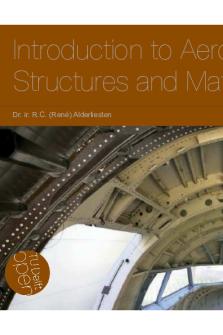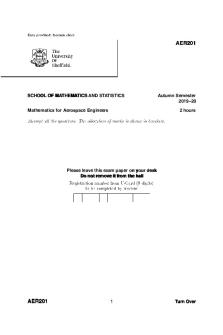MAS156 Mathematics (Electrical and Aerospace) Spring Semester 2014-2015 PDF

| Title | MAS156 Mathematics (Electrical and Aerospace) Spring Semester 2014-2015 |
|---|---|
| Course | Mathematics (Electrical and Aerospace) |
| Institution | University of Sheffield |
| Pages | 5 |
| File Size | 139.6 KB |
| File Type | |
| Total Downloads | 50 |
| Total Views | 132 |
Summary
Exam Paper...
Description
Data provided: Formula Sheet
MAS156
SCHOOL OF MATHEMATICS AND STATISTICS MAS156 Mathematics (Electrical and Aerospace)
Spring Semester 2014–2015 2 hours 30 minutes
Attempt ALL questions. Each question in Section A carries 2 or 3 marks and each question in Section B carries 8 marks.
Section A
A1
Give an example of a function f which has a minimum at x = 0 but which has f ′′ (0) = 0. Give an example of a function g which has g ′ (2) = 0 but which does not have a minimum or a maximum at x = 2. (2 marks)
A2
Calculate
A3
Calculate the angle between the vectors (1, 2, 3) and (4, 5, 6).
A4
Find all complex numbers z that satisfy the equation |z − 1| = |z − j|. (3 marks)
A5
∂ 2f where f (x, y) = y sin(xy). ∂x∂y
Evaluate the indefinite integral
MAS156
Z
x2 dx. 1+x 1
(3 marks)
(3 marks)
(3 marks)
Turn Over
MAS156 A6
Find the general solution of the differential equation t
dy dt
+ 2y =
1 − 2s . s2 + 6s + 13
A7
Find the inverse Laplace transform of the function
A8
Find lim
A9
1 −2 1 Evaluate the determinant of the matrix M = 3 0 2 . −1 −2 2
A10
√
x sin 2x . x→π/2 π − 2x
t. (3 marks)
(3 marks)
(3 marks)
Find the eigenvalues of the matrix M =
3 2 −1 1
.
(3 marks)
(3 marks)
Section B
B1
Find the solutions of z 4 = j and plot them on the Argand plane. Find the solutions of (w − 1)4 = j .
B2
State, without proof or justification, the limits sin(x) and x→0 x lim
cos(x) − 1 . x→0 x lim
Give the definition of the derivative of a function f at the point x = a. Use this to prove from first principles that if f (x) = sin(x) then f ′ (a) = cos(x).
B3
State the domain and range of each of the following functions: f (x) = cosh(x) and g(x) = arccosh(x). Suppose that y = arcsinh(x) and z = ey . Show that z 2 − 2xz − 1 = 0. Find z and hence deduce a formula for arcsinh(x) in terms of x.
MAS156
2
Continued
MAS156 B4
Let I(a) =
Z
x2
dx , where a is a constant. + 4x + a
Find the indefinite integral I(a) when (i) a = 0,
B5
(ii)
a = 4,
(iii)
a = 5.
Find the general solution of the differential equation d2 y dy + 6 + 13y = sin 2t. 2 dt dt Show that as t → ∞, y is approximately equal to α sin(2t − φ), and determine the values of α and φ.
B6
(i)
Sketch the function f (x) = e−x cos 10x,
x ≥ 0.
Show from your sketch that the equation e−x cos 10x = 2x, has a single solution x∗ ∈ (0, π/20). (ii)
x≥0
Devise the Newton-Raphson iterative scheme to solve the equation e−x cos 10x − 2x = 0,
x ≥ 0.
Using x0 = 0.1 as a first approximation, use this scheme to find the solution correct to four decimal places.
B7
(i)
Find the relationship between α and β if the system of equations x − 2y + z = 0
2x + y + z = 0 4x + αy + βz = 0
has a non-trivial solution. Find the general solution when this relationship holds. (ii)
Find the values of α and β for which the equations x − 2y + z = 0 2x + y + z = 5
4x + αy + βz = 0 have infinitely many solutions.
End of Question Paper MAS156
3
Turn Over
Formula Sheet for MAS156 Trigonometry cos2 θ = (1 + cos 2θ)/2 sin2 θ = (1 − cos 2θ)/2 sin 2θ = 2 sin θ cos θ Hyperbolic Functions cosh2 θ = (1 + cosh 2θ)/2 sinh2 θ = −(1 − cosh 2θ)/2 sinh 2θ = 2 sinh θ cosh θ Binomial theorem n(n − 1) 2 n r (1 + x) = 1 + nx + x + ... + x + ... 2! r n
n(n − 1)(n − 2) . . . (n − r + 1) n . = where r! r If n is a positive integer then the series terminates and the result is true for all x, otherwise, the series is infinite and only converges for |x| < 1. Function sin x cos x tan x cosec x sec x cot x sinh x cosh x tanh x x sin−1 a x cos−1 a x tan−1 a x sinh−1 a x cosh−1 a x tanh−1 a
Derivative cos x − sin x sec2 x −cosec x cot x sec x tan x −cosec2 x cosh x sinh x sech2 x 1 √ 2 a − x2 √
−1 a2 − x2
a a2 + x2 √
x2
√
x2
1 + a2
1 − a2
a a2 − x2
4
Integration-by-Parts Z Z ′ uv dx = uv − u′ v dx Substitution for a Rational Function of sin x and cos x x 2t dx 2 1 − t2 then sin x = and = If t = tan , cos x = . 2 2 2 1+t dt 1 + t2 1+t Taylor expansion of f (x) about x = a f (a) + (x − a)f (1) (a) +
(x − a)n−1 (n−1) (x − a)2 (2) f (a) + . . . + f (a) + . . . 2! (n − 1)!
Newton-Raphson formula for the root of f (x) = 0 xn+1 = xn −
f (xn ) f ′ (xn )
Table of Laplace transforms f (t)
F (s) = L(f (t))
tn
n! (n = 0, 1, 2, . . .) sn+1
eat
1 s−a
sin ωt cos ωt sinh ωt cosh ωt
s2
ω + ω2
s2
s + ω2
ω s2 − ω 2 s2
s − ω2
eat f (t)
F (s − a) (shift theorem)
f ′ (t)
sF (s) − f (0)
f ′′ (t)
s2 F (s) − sf (0) − f ′ (0)
MAS156
5...
Similar Free PDFs

GBE notes - Spring Semester
- 82 Pages

AEROSPACE DESIGN
- 438 Pages

Content of the spring semester
- 3 Pages

Exam 1 Spring semester 2016
- 13 Pages

Electrical Conductivity AND OHM
- 3 Pages

Electrical and Electronics Measurment
- 652 Pages

Chapter 10 - aerospace h10
- 32 Pages
Popular Institutions
- Tinajero National High School - Annex
- Politeknik Caltex Riau
- Yokohama City University
- SGT University
- University of Al-Qadisiyah
- Divine Word College of Vigan
- Techniek College Rotterdam
- Universidade de Santiago
- Universiti Teknologi MARA Cawangan Johor Kampus Pasir Gudang
- Poltekkes Kemenkes Yogyakarta
- Baguio City National High School
- Colegio san marcos
- preparatoria uno
- Centro de Bachillerato Tecnológico Industrial y de Servicios No. 107
- Dalian Maritime University
- Quang Trung Secondary School
- Colegio Tecnológico en Informática
- Corporación Regional de Educación Superior
- Grupo CEDVA
- Dar Al Uloom University
- Centro de Estudios Preuniversitarios de la Universidad Nacional de Ingeniería
- 上智大学
- Aakash International School, Nuna Majara
- San Felipe Neri Catholic School
- Kang Chiao International School - New Taipei City
- Misamis Occidental National High School
- Institución Educativa Escuela Normal Juan Ladrilleros
- Kolehiyo ng Pantukan
- Batanes State College
- Instituto Continental
- Sekolah Menengah Kejuruan Kesehatan Kaltara (Tarakan)
- Colegio de La Inmaculada Concepcion - Cebu








